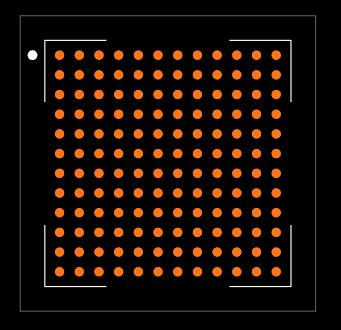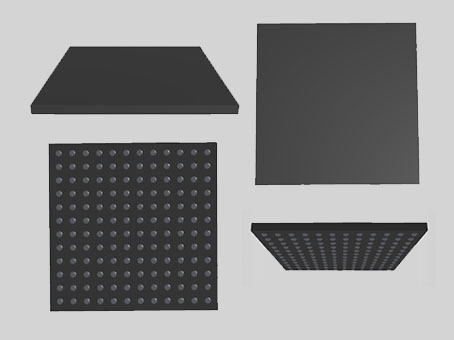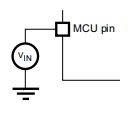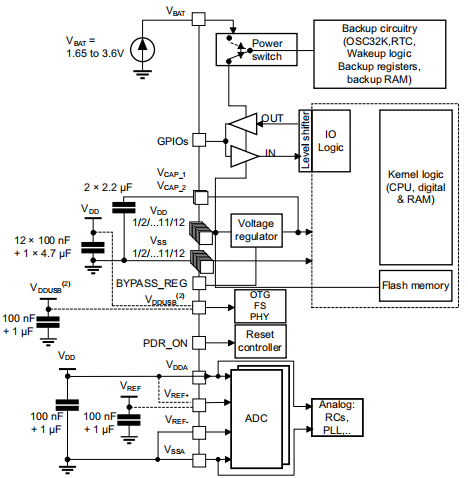STM32F446: Pinout, Specifications, and Datasheet
This article offers an in-depth exploration of the STM32F446 microcontrollers, which are built around the powerful Arm® Cortex®-M4 32-bit RISC processor and designed to deliver high performance up to 180 MHz. It provides a detailed examination of circuit design, pin configurations, datasheets, and other technical specifics for understanding and utilizing this series in various high-demand applications. The emphasis on both performance and energy efficiency makes these microcontrollers suitable for a range of industrial and electronics applications. Through comprehensive technical analysis, this article aims to enhance understanding of the STM32F446's architecture and facilitate its integration into innovative technological solutions.Catalog

Overview of the STM32F446 Series
The STM32F446 series, which utilizes the Arm® Cortex®-M4 processor, showcases advanced capabilities in embedded system design. With speeds reaching up to 180 MHz and the inclusion of a floating-point unit, the series enhances processes involving single-precision calculations. Memory protection features and DSP instructions are use in maintaining the integrity of programs, especially within intricate project settings. This series integrates high-speed flash memory of up to 512 Kbytes, alongside 128 Kbytes of SRAM and up to 4 Kbytes of backup SRAM. This combination enables demanding applications to achieve rapid data access and storage, efficiently managing an extensive range of I/Os and peripherals via multiple bus systems. The structure simplifies the execution of intricate tasks.
To maximize performance, strategic task allocation such as delegating complex calculations to specialized units serves to elevate the overall efficiency of the system. Outfitted with three 12-bit ADCs and two DACs, the STM32F446 series excels in processing precise analog signals. A low-power RTC is instrumental in scenarios requiring careful time management with limited power resources. Various timers, including those designed for PWM and motor control, provide sophisticated control options in automation and robotic applications. The series features extensive communication interfaces that enable broad connectivity, ideal for integrated systems within today's technological landscape. These interfaces support fluid interaction with external devices, promoting robust and data interchange. Focusing on connection stability and minimizing latency is need in ensuring that systems are not only responsive but also dependable.
STM32F446 Pin Configuration

STM32F446 Footprint and CAD Model


Features of STM32F446
Memory and Compatibility
Memory resources in the microcontroller include 512 Kbytes of Flash and 128 Kbytes of SRAM. This capacity is adaptable to various sophisticated tasks, thanks to its flexibility in supporting a broad spectrum of external memory types. Many enjoy the freedom to adapt system designs to accommodate specific data processing and storage needs.
Connectivity Options
With exceptional connectivity, the STM32F446 features numerous interfaces, such as USB, I2C, USARTs, SPIs, and CAN. These options ensure smooth interoperability among different devices and systems, serving a wide range of industrial and consumer needs. The diverse connectivity offerings are instrumental in crafting effective IoT solutions, where system interactions demand attentiveness.
Enhanced Functionality
The microcontroller presents a dual-mode QuadSPI interface that speeds up data transmission, for applications where timing impacts outcomes. Sophisticated clock and power management support smart energy use, enabling power-saving techniques while maintaining performance integrity. Additionally, the varied power modes allow for adaptive energy solutions tailored to distinct operational demands.
Timer and Interrupt Capabilities
It provides support for applications, with its comprehensive timers and interrupt capabilities that ensure precise control. This can be noteworthy in automation and robotics, where accuracy in timing can transform system effectiveness. Adeptly tuning these timers can markedly improve the dynamism of such systems.
Advanced Debugging Interfaces
Advanced debugging tools empower to conduct thorough system analyses and effectively troubleshoot potential issues. This capacity to dissect system behavior reduces development cycles while enhancing the end product's dependability. The role of sophisticated debugging interfaces in crafting successful, enduring solutions. Integrating a robust array of high-performance computing, broad connectivity, and adept energy management, the STM32F446 microcontroller is equipped to meet the needs of diversified applications. This blend of features positions it as an optimal choice for engineering efforts that balance innovation with practical demands.
STM32F446 Specifications
Technical specifications, features, and parameters of the STMicroelectronics STM32F446, along with components comparable to the STM32F446ZCH6.
|
Type |
Parameter |
|
Lifecycle Status |
ACTIVE (Last Updated: 6 months ago) |
|
Surface Type |
RoHS |
|
Mounting Type |
Surface Mount |
|
Number of Pins |
144 |
|
Package / Case |
144-LFBGA |
|
Data Converters |
ADC 16-bit, DAC 24-bit |
|
Packaging |
Cut Tape (CT) |
|
Series |
STM32H7 |
|
Solder Mask Assembly Lead (SML) |
Pb (Lead) |
|
ECCN Code |
5A991.a-2 |
|
Terminal Finish |
Sn |
|
Terminal Pitch |
0.5mm |
|
Terminal Position |
BOTTOM |
|
Frequency |
550MHz |
|
Supply Voltage-Min (V) |
1.71V |
|
Supply Voltage-Max (V) |
3.6V |
|
Supply Voltage-Typ (V) |
1.8V |
|
Voltage - Supply (Max) |
3.6V |
|
Oscillator Type |
Internal |
|
Program Memory Size |
2GB |
|
Program Memory Type |
FLASH |
|
Supply Current |
150mA |
|
I/O Pins |
168 |
|
Pin Changeable |
Yes |
|
CPU Family |
ARM Cortex-M7 |
|
External Bus Data Width |
32 |
|
Width |
7mm |
|
Lead Status |
RoHS Compliant |
|
Factory Lead Time |
12 Weeks |
|
Package / Case |
144-LFBGA |
|
Number of I/Os |
168 |
|
Operating Temperature |
-40°C to +105°C |
|
Part Status |
Active |
|
Number of Terminations |
144 |
|
Terminal Position |
BOTTOM |
|
Supply Voltage |
1.8V |
|
Frequency |
550MHz |
|
Data Rate - Max |
2400 MT/s |
|
Memory Size |
256kB |
|
RAM Size |
1GB |
|
Cellular / Wi-Fi / Bluetooth |
GSM, GPRS, EDGE, WCDMA, LTE, Bluetooth, Wi-Fi |
|
Cores |
1 |
|
Channels |
32 |
|
Bus Channels |
12 |
|
Address Bus Width |
32 |
|
Data Bus Width |
32 |
|
Length |
7cm |
|
Width |
7cm |
|
RoHS Status |
RoHS Compliant |
Functional Block Diagram of STM32F446

Loading Capacitor of STM32F446

Loading capacitors are instrumental in maintaining steady voltage levels while effectively reducing noise in electronic circuits. They manage transient responses, thus shaping circuit functionality. By carefully selecting and positioning these capacitors, you can bolster signal integrity and curb electromagnetic disturbance. Accurate assessment of pin parameters under diverse loading scenarios is a step towards validating design premises and implementing requisite modifications. Utilizing state-of-the-art measurement approaches, including time-domain reflectometry, sheds light on the complex interactions between capacitors and additional circuit components.
Pin Input Voltage of STM32F446

Efficient circuit design hinges on a nuanced understanding of voltage parameters, forming a blueprint that not only fosters component compatibility but also bolsters system dependability. Aligning to these voltage norms helps sidestep harmful variations, which could potentially destabilize circuits. A well-executed voltage plan impacts the durability and continued functionality of electronic devices. Embarking on circuit design calls for attention to proven approaches, ensuring all pins are precisely regulated for effective operation. The use of top-tier voltage reference components holds down voltage uniformity across the board, thereby sustaining signal quality. Integrating feedback loops into designs allows for immediate voltage adjustments amidst variations, keeping performance at its peak.
Power Supply Scheme of STM32F446

Power Supply Basics
The power supply setup must ensure VDDA and VSSA are connected to VDD and VSS, respectively. This arrangement helps align the power references for both analog and digital sections of the circuit, reducing potential mismatches that could disrupt functionality. Mixed-signal environments demand a harmonious power balance, as it deeply influences the overall system's operational trustworthiness.
USB Power Management Details
Certain package configurations benefit from devoted USB power management. This functionality stabilizes operations across diverse device setups. USB power management mitigates the influence of power surges on connected peripherals, especially in portable and compact devices where space-saving and power use optimization are admired. These insights stem from design practices that prioritize load stability.
Role of Stable Power Settings
Establishing a reliable power layout holds importance. Power supply line instabilities or noise can result in erratic functionality, affecting device efficiency. In intricate systems, strong power management effectively boosts dependability and output, mirroring industry standards that rely on rigorous testing and validation to uphold exceptional quality.
Enhancing Power Supply Durability
To boost sturdiness, the deployment of filtering capacitors near power connections can be beneficial. They suppress voltage fluctuations and minimize noise, delivering a cleaner power source. Employing precise grounding strategies and crafted PCB pathway designs can further counter potential disruptions. These approaches reflect the reality where thoughtful design adjustments lead to noticeable enhancements in device efficiency.
Applications of STM32F446
Versatility of STM32F446
The STM32F446 microcontroller stands out for its adaptability across a diverse range of applications, from IoT systems to industrial environments. It addresses varied technological needs, enhancing both automation and electronics.
Role in IoT
In the IoT ecosystem, the STM32F446 contributes to enhanced connectivity and data handling. It underpins sophisticated networking protocols, enabling smart devices to communicate efficiently. This supports applications such as smart homes and intelligent transport systems, where reliable connectivity is needed.
Automation and Control
In industrial settings, the STM32F446 is use for advancing automation and fine-tuned control. It enables the seamless integration of sensors and actuators for contemporary manufacturing and quality assurance processes.
Manufacturing Practices
Industries utilizing the STM32F446 for motor control and automation report enhanced operational efficiency and product quality, reflecting its role in transforming industrial methodologies.
Motor Control
Exceptional performance in motor control is a hallmark of this microcontroller, offering precise control over speed and position. It is prevalent in robotics and electric vehicles, where exactness and power efficiency are great.
Medical Equipment
In medical equipment, the STM32F446 is celebrated for its dependability and safety features. It facilitates the creation of devices from portable diagnostics to intricate monitoring systems for precise patient care.
Consumer and Home Appliances
In home appliances, the STM32F446 brings advanced features like energy-efficient operations and intelligent control systems, enriching and advancing sustainability. Smart appliances, such as washing machines and refrigerators, use these microcontrollers to boost energy efficiency and operational adaptability, meeting expectations for tech-integrated living.
STM32F446 Packaging

STM32F446 Manufacturer Information
STMicroelectronics emerges as a leader in semiconductor innovation, offering advanced solutions in microelectronics. This drive is evident in its strong focus on System-on-Chip (SoC) technology, embodying a passion for shaping the future of modern electronics. Through strategic alliances and foresight, STMicroelectronics boosts its capacity to tackle complex challenges. This strategy proves in navigating swift consumer demand shifts, ensuring the company remains adaptable and strong. With a wealth of expertise and a commitment to collaborative growth, STMicroelectronics continues to impact the semiconductor industry.
Datasheet PDF
STM32F446ZCH6 Datasheets:
Material Barrier Bag 17/Dec/2020.pdf
Mult Dev A/T Chgs 13/Dec/2021.pdf